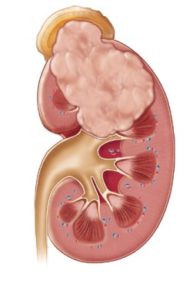
Percutaneous ablation can be successfully used to treat many cases of early-stage renal cell carcinoma, a new study published in the Annals of Internal Medicine, led by a team at Weill Cornell Medicine and New York-Presbyterian, suggests.
The study was an observational cohort analysis evaluating the outcomes of 4,310 early-stage kidney cancer patients aged 66 and older with tumours under 4cm in a large national registry. The investigators found that percutaneous ablation is associated with fewer complications and lower rates of renal failure for older patients compared with radical nephrectomy (where the kidney is removed). Radical nephrectomy is the standard of care in these older patients.
“For older patients with this type of early-stage kidney cancer, percutaneous ablation should be considered as an alternative to radical nephrectomy,” says lead study author Adam Talenfeld, an assistant professor of clinical radiology at Weill Cornell Medicine and a radiologist at New York-Presbyterian/Weill Cornell Medical Center (New York, USA).
The study authors conclude, “For well-selected older adults with T1a renal cell carcinoma, percutaneous ablation may result in oncologic outcomes similar to those of radial nephrectomy, but with less long-term renal insufficiency and markedly fewer periprocedural complications.”
Kidney tumours are often detected incidentally when doctors obtain imaging studies on patients for other medical reasons. Most of these tumours are classified as stage T1a, being golf-ball sized or smaller—about a third of a normal kidney length in size—and not having yet grown outside the organ.
The first treatment choice for T1a kidney tumours is a surgery, partial nephrectomy, that removes the tumour, but spares most of the affected kidney. However, partial nephrectomy is a more complex procedure with a higher risk of bleeding and other complications. For older patients, doctors sometimes opt for the simpler radical nephrectomy, even though that effectively halves kidney function.
“Older patients, who are already at increased risk for chronic renal failure, should not always have to get their kidney taken out for a golf-ball or smaller sized tumour,” Talenfeld says. “There really has been a need for better alternatives.”
The study investigators found that, compared with partial nephrectomy, percutaneous ablation may be associated with slightly shorter renal cell carcinoma-specific survival, and fewer periprocedural complications.
Over the past decade, doctors increasingly have used percutaneous ablation as a treatment option for stage T1a kidney cancers, but much less frequently than the two main surgical options, in part due to the lack of comparative clinical study data. Comparing outcomes in clinical trials of early-stage kidney cancer treatments has been challenging, since these tumours tend to grow very slowly.
For the study, Talenfeld and his team analysed information from a large patient registry kept by the National Cancer Institute and linked with each patient’s Medicare claims. Their analysis, involving 4,310 kidney cancer patients, found that survival five years after percutaneous ablation was very similar to survival after radical nephrectomy: 98% and 95% kidney cancer-related survival, respectively, and approximately 75% survival overall for all patients. However, percutaneous ablation was associated with lower rates of new-onset chronic renal failure within the first year (11% compared with 18%) and much lower rates of other complications requiring emergency department or hospital admissions within 30 days of intervention (6% compared with 30%).
Of those patients who has partial nephrectomy, 10% had intraoperative conversion to radical nephrectomy. Meanwhile, 7% of patients in the percutaneous ablation group received additional percutaneous ablation within one year of treatment.
Percutaneous ablation also resulted in fewer complications than partial nephrectomy, though a conclusive comparison of survival outcomes was difficult since patients receiving partial nephrectomy surgery were typically significantly younger and healthier on average.
The study authors did list as a limitation to this study the fact that findings from an older study population are probably less applicable to younger patients. Notably, though, the average age of diagnosis of kidney cancer is 64.
However, Talenfeld says, “These results are the best evidence we have so far in support of percutaneous ablation for T1a renal cancer. This study suggests that for many older patients requiring surgical treatment, percutaneous ablation should be the next choice after partial nephrectomy.”
Talenfeld and his colleagues now hope to do additional comparative studies of these procedures, using more recent patient data and including cost comparisons.













